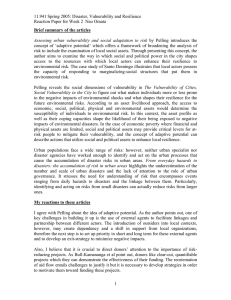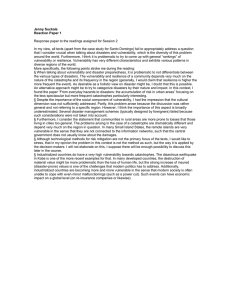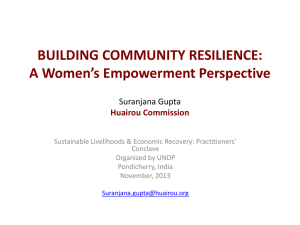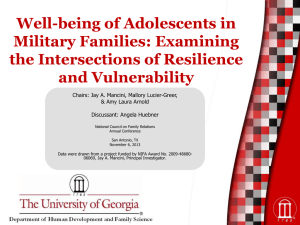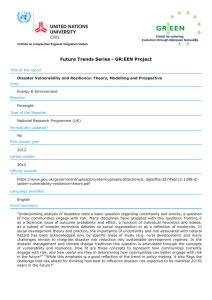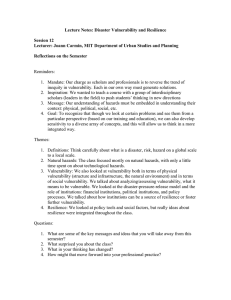Vulnerability, resilience, hazard, risk, damage, and loss: a socio
advertisement
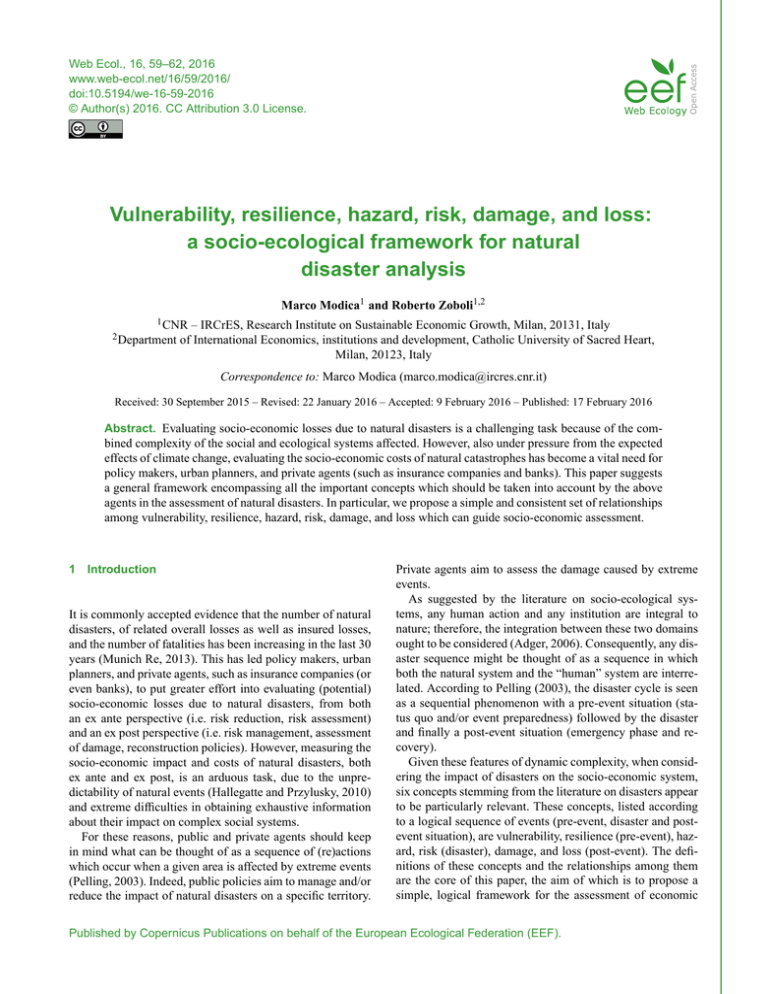
Web Ecol., 16, 59–62, 2016 www.web-ecol.net/16/59/2016/ doi:10.5194/we-16-59-2016 © Author(s) 2016. CC Attribution 3.0 License. Vulnerability, resilience, hazard, risk, damage, and loss: a socio-ecological framework for natural disaster analysis Marco Modica1 and Roberto Zoboli1,2 1 CNR 2 Department – IRCrES, Research Institute on Sustainable Economic Growth, Milan, 20131, Italy of International Economics, institutions and development, Catholic University of Sacred Heart, Milan, 20123, Italy Correspondence to: Marco Modica (marco.modica@ircres.cnr.it) Received: 30 September 2015 – Revised: 22 January 2016 – Accepted: 9 February 2016 – Published: 17 February 2016 Abstract. Evaluating socio-economic losses due to natural disasters is a challenging task because of the combined complexity of the social and ecological systems affected. However, also under pressure from the expected effects of climate change, evaluating the socio-economic costs of natural catastrophes has become a vital need for policy makers, urban planners, and private agents (such as insurance companies and banks). This paper suggests a general framework encompassing all the important concepts which should be taken into account by the above agents in the assessment of natural disasters. In particular, we propose a simple and consistent set of relationships among vulnerability, resilience, hazard, risk, damage, and loss which can guide socio-economic assessment. 1 Introduction It is commonly accepted evidence that the number of natural disasters, of related overall losses as well as insured losses, and the number of fatalities has been increasing in the last 30 years (Munich Re, 2013). This has led policy makers, urban planners, and private agents, such as insurance companies (or even banks), to put greater effort into evaluating (potential) socio-economic losses due to natural disasters, from both an ex ante perspective (i.e. risk reduction, risk assessment) and an ex post perspective (i.e. risk management, assessment of damage, reconstruction policies). However, measuring the socio-economic impact and costs of natural disasters, both ex ante and ex post, is an arduous task, due to the unpredictability of natural events (Hallegatte and Przylusky, 2010) and extreme difficulties in obtaining exhaustive information about their impact on complex social systems. For these reasons, public and private agents should keep in mind what can be thought of as a sequence of (re)actions which occur when a given area is affected by extreme events (Pelling, 2003). Indeed, public policies aim to manage and/or reduce the impact of natural disasters on a specific territory. Private agents aim to assess the damage caused by extreme events. As suggested by the literature on socio-ecological systems, any human action and any institution are integral to nature; therefore, the integration between these two domains ought to be considered (Adger, 2006). Consequently, any disaster sequence might be thought of as a sequence in which both the natural system and the “human” system are interrelated. According to Pelling (2003), the disaster cycle is seen as a sequential phenomenon with a pre-event situation (status quo and/or event preparedness) followed by the disaster and finally a post-event situation (emergency phase and recovery). Given these features of dynamic complexity, when considering the impact of disasters on the socio-economic system, six concepts stemming from the literature on disasters appear to be particularly relevant. These concepts, listed according to a logical sequence of events (pre-event, disaster and postevent situation), are vulnerability, resilience (pre-event), hazard, risk (disaster), damage, and loss (post-event). The definitions of these concepts and the relationships among them are the core of this paper, the aim of which is to propose a simple, logical framework for the assessment of economic Published by Copernicus Publications on behalf of the European Ecological Federation (EEF). 60 Marco Modica and Roberto Zoboli: Vulnerability, resilience, hazard, risk, damage, and loss losses due to extreme events, thus providing a useful tool for natural disaster policy. The paper is organized as follows: the next section illustrates the general framework, Sect. 3 examines individual aspects of the framework, and Sect. 4 concludes the analysis. 2 A socio-ecological framework for natural disasters Vulnerability, resilience, hazard, risk, damage, and loss are the key concepts referred to in the literature on natural disasters. The relationships among these elements are often taken into account in the same literature: Sarewitz et al. (2003) identify a distinction between vulnerability and risk, Adger (2006) suggests a potential convergence between vulnerability and resilience, while Baritto (2008) argues that there is a correlation between vulnerability and economic losses. However, a general framework encompassing all the aspects of these relationships is still missing in the literature. Policy makers (as well as private agents, such as insurers and banks) dealing with extreme events have to consider all the variables and characteristics of the systems under analysis. As noted by Sarewitz et al. (2003), limiting “risk management” policies to just one or few of the aspects mentioned above might lead to wrong implications and, as a consequence, increase exposure to disaster losses. Sarewitz et al. (2003) identify three main weaknesses of partial approaches (for the sake of completeness, they only explore the relationship between risk and vulnerability, identifying six weakness. We exclude three weaknesses which are not directly related to the matter of this paper and we also include considerations on resilience and outcome loss). Firstly, some approaches aim to cover the costs of disasters based only on risk assessment. These approaches do not rely for their success on reducing the level of vulnerability or on increasing the level of resilience of a given area. However, reduction in vulnerability and improvement of resilience may limit output losses. For these reasons, it would be advisable to include both aspects in the evaluation of the losses produced by a natural disaster and their impact on the economy. Secondly, approaches aiming to prepare for extreme events based only on risk need sophisticated and rigorous probabilistic models. Yet, in some cases, a precise assessment of risk is impossible (i.e. earthquake prediction), and practices and policies based on these approaches might lead to harmful effects. An example of this is the definition of the so-called “red zone”, the urbanized area surrounding Mount Vesuvius, the famous volcano in Italy. According to the Italian Civil Protection Department, the “red zone” is the area most exposed to pyroclastic flows in case of an eruption and municipalities in the “red zone” are included in the national evacuation plan. However, the “red zone” was enlarged in 2014 to include nine additional municipalities because of more precise studies. Hence, an eruption before 2014 would have resulted in an evacuation plan designed for a lower numWeb Ecol., 16, 59–62, 2016 ber of people than those actually involved. This might have led to deficient crisis management, with higher probability of casualties both in the municipalities already in the “red zone” and in those included in the “red zone” after 2014. Since the disaster would have involved a number of people greater than that expected, the institutions would not have been sufficiently prepared to deal with this, weakening the organizational crisis system. Moreover, this might have led to poorer prevention measures and preparedness of people. Thirdly, assessments of resilience and vulnerability do not include evaluation of disaster risk. Yet, “vulnerability [and resilience are] not divorced from probability but the vulnerability [and resilience] management do not depend on precise predictive quantifications of specific future events” (Sarewitz et al., 2003, p. 807). This section reviews all the aspects mentioned above in order to take a few steps forward in building a socio-ecological framework for natural disasters. For each of the aspects there are several definitions, interpretations, and facets. However, we will report only the interpretations which we consider important in the definition of a general framework to evaluate economic losses due to extreme events, and we will refer to other authors for their complete discussion. The rationale for the choice of the definitions reported below is based on the work by Cutter et al. (2008). Indeed, they claim that the relationships among most of the concepts analysed here are not well defined (especially among vulnerability, resilience, and damage). Some researchers believe these notions to be part of the same concept, while other authors claim that each is the outcome of another or that they are separate but linked concepts. We will consider the aspects below as separate notions, preferring the definitions that are closer to this view. In the following paragraphs, we will provide explanations of six important concepts whose interrelationships are illustrated in Fig. 1. Vulnerability can be used “to describe inherent characteristics of a system that create the potential for harm but are independent of the probabilistic risk of occurrence of any particular hazard or extreme event” (Sarewitz et al., 2003, p. 805). For a complete review of vulnerability, readers may refer to Adger (2006) and Cutter et al. (2008). Resilience refers to (i) the ability of a system to recover after a shock (Pimm, 1984); (ii) the amount of shock that a system is able to absorb (Holling, 1973); and (iii) the ability of a system to adapt so as to minimize the extent of disturbances affecting the system (Martin, 2012). It should be noted here that the third definition of resilience is not yet well-established knowledge in the literature, and some authors – for instance, Rose and Krausmann (2013) – treat adaptive resilience as a characteristic of resilience and not just as another definition in itself. Readers can refer to Foster (2007), Martin (2012), and Modica and Reggiani (2015). Hazard “refers to the natural events that may affect different places singly or in combination (coastlines, hillsides, earthquake faults, savannahs, rainforests, etc.) at different www.web-ecol.net/16/59/2016/ Marco Modica and Roberto Zoboli: Vulnerability, resilience, hazard, risk, damage, and loss Figure 1. The socio-ecological framework for the evaluation of economic losses due to extreme events. times (season of the year, time of day, over return periods of different duration)” (Wisner et al., 2004, p. 45). Risk ought to be thought of as “a product of three major elements: exposure to hazards (e.g. that which is affected by natural disasters), the frequency or severity of the hazard and the vulnerability” (Birkmann, 2007, p. 21). More precisely, it is the likely level of loss from a given magnitude of hazard combined with the potential for harm (Alexander, 2000). Damage attempts to measure, in economic terms, the degree of harm which structures or other physical assets have suffered due to a catastrophic event. Loss is “the change in wealth caused by damage to structures or other physical assets” (Kliesen, 1994, p. 1), and it can be split into either direct or indirect losses; market vs. nonmarket effects; redistribution and wealth (see ECLAC, 2003; FEMA, 1992; and Pelling et al., 2002, for more details). 3 Critical explanation of the framework As mentioned in Sect. 1, in the analysis of the economic losses caused by natural disasters in a given area, a key point to be kept in mind is that the socio-economic system is integral to nature. Therefore, human activity is contingent on the natural system and, at the same time, the natural system is affected by human activity. For the sake of clarity, we need to explain what we mean by natural and socio-economic systems. A natural system might be defined as all the factors which influence human beings, spontaneously regulated by the course of nature, namely everything that exists in nature (physical or biological materials) or that is created by the forces of nature (including disasters, i.e. intertwined processes involving both physical and biological materials), in contrast to human production. A socio-economic system is a system in www.web-ecol.net/16/59/2016/ 61 which goods and services are produced and exchanged and resources are allocated. The socio-economic system also includes individuals and institutions, as well as all the relationships among individuals (e.g. social) and between individuals and institutions (e.g. socio-economic). Consequently, the natural system and the socio-economic system are interrelated and they mutually influence the evolution of their system components (consider, for instance, the effects of global warming on human activity or the remark that in the Alpine habitat “analogous geographical conditions always entail analogous development”, Viazzo, 1989, p. 16). Then, within the framework described in Sect. 2, the natural system is intrinsically related to hazard (since it is a product of nature). Instead, the socio-economic system is only indirectly related to hazard through the impact which it exerts on the natural system (e.g. the intensity of a flood caused by heavier rainfalls ascribable to global warming). At the same time, the socio-economic system is intrinsically related to exposure because it depends on human activities (e.g. building a bridge is per se a form of exposure). Both natural and socio-economic systems influence the vulnerability and resilience of the area of interests. Indeed, suppose that a given region has an endemic shortage of drinking water. This area is more vulnerable to natural disasters than other areas having a greater supply of water. Indeed, this condition is an inherent characteristic enhancing the potential for harm in case of a natural disaster (i.e. a natural disaster which further reduces the “stock” of drinking water). Similarly, a lack of drinking water might also reduce the ability of the area to recover after a natural disaster strikes, thus reducing the resilience of the territory. Furthermore, the socio-economic system influences the vulnerability and the resilience of the area of interest. A region with higher GDP per capita will be less vulnerable (i.e. its population lives in structurally less vulnerable buildings) and more resilient (i.e. its population has the financial resources needed to recover quickly). However, the difference between vulnerability and resilience, as mentioned above, is rather subtle and, as noted by Cutter et al. (2008), it is not clearly defined even at the research level. Still according to Cutter et al. (2008), there are scholars who consider resilience an outcome of vulnerability (i.e. lower vulnerability leads to greater recovering capacity, Manyena, 2006). Differently, resilience might be seen as a “stand-alone” concept, only loosely related to vulnerability since it “is defined more in terms of continual learning and taking responsibility for making better decisions to improve the capacity to handle hazard” (Cutter et al., 2008, p. 600). Finally, vulnerability and resilience might be considered two different concepts which nonetheless share common characteristics. The latter is our view, as seen in the examples above, where the same aspects shape the concepts of both vulnerability and resilience (i.e. shortage of drinking water and GDP per capita). Yet, there are other aspects which are related to only one of the two concepts. For example, insurance against Web Ecol., 16, 59–62, 2016 62 Marco Modica and Roberto Zoboli: Vulnerability, resilience, hazard, risk, damage, and loss natural disasters cannot reduce the damage (i.e. the degree of harm) caused by an extreme event but might reduce losses due to a catastrophic event (i.e. change in wealth), since it compensates the change in wealth caused by the damage without reducing the level of vulnerability. Notice also that insurance might also lead to perverse behaviours which increase vulnerability (e.g. moral hazard). Hence, resilience and vulnerability are two different aspects which are related to loss and damage respectively. Nevertheless, both damage and loss have an impact on the socio-economic system because the cost of natural disasters affecting a certain area might absorb financial resources from other socio-economic sectors. This effect will definitely change the socio-economic system and, consequently, it will have effects on the natural system, as well as on vulnerability, resilience, hazard, risk, damage, and loss – a situation which might continue until the next extreme event. 4 Conclusions This paper outlines a general framework to evaluate (potential) socio-economic losses due to natural disasters which can be used by policy makers, urban planners, or private agents. In particular, we address concepts such as vulnerability, resilience, hazard, risk, damage, and loss and we illustrate a set of links among some of these concepts. The chain of (re)actions emerging from the analysis can be useful to better understand and assess the costs of extreme events. This framework stresses important features, helping public and private agents to focus on the characteristics which might reduce the damage and losses caused by natural disasters and improve the ability of affected areas to recover from the shock or to implement adaptation strategies. Acknowledgements. The authors wish to thank C. Ghisetti, two anonymous reviewers, and the editor for their comments, which greatly helped to improve the paper. The authors also acknowledge the support received by the project “The Economic Evaluation of Natural Disasters in Italy” (sponsored by Fondazioni Generali), as well as the joint Project INTEGRATE (“Technological Innovation for a Rational Management of Urban Constructions”) launched by the National Research Council (CNR, Italy) and Regione Lombardia (Italy). Edited by: R. Brandl Reviewed by: C. Ghisetti and two anonymous referees References Adger, W. N.: Vulnerability, Global Environ. Chang., 16, 268–281, 2006. Alexander, D. E.: Confronting Catastrophe: New Perspectives on Natural Disasters, Terra and Oxford University Press, Harpenden, UK and New York, 2000. Web Ecol., 16, 59–62, 2016 Baritto, F.: Disasters, Vulnerability and Resilience from a MacroEconomic Perspective: Lessons from the Empirical Evidence. Background paper for the 2009 ISDR Global Assessment Report on Disaster Risk Reduction, Geneva, International Strategy for Disasters Reduction, 2008. Birkmann, J.: Risk and vulnerability indicators at different scales: Applicability, usefulness and policy implications, Environmental Hazards, 7, 20–31, 2007. Cutter, S., Barnes, L., Berry, M., Burton, C., Evans, E., Tate, E., and Webb, J.: A place-based model for understanding community resilience to natural disasters, Global Environ. Chang., 18, 598–606, 2008. ECLAC: Handbook for Estimating the Socio-economic and Environmental Effects of Disasters, United Nations Economic Commission for Latin America and the Caribbean, 2003. FEMA: Indirect Economic Consequences of a Catastrophic Earthquake, edited by: Milliman, J. W. and Sanguinetty, J. A., National Earthquake Hazards Reduction Program, 1992. Foster, K. A.: Case study approach to understanding regional resilience, Working paper 2008–07, Institute of Urban and Regional Development, University of California, Berkeley, 2007. Hallegatte, S. and Przylusky, V.: The economics of natural disasters. Concepts and Methods, Policy Research Working Paper 5507, 2010. Holling, C. S.: Resilience and stability of ecological systems, Annu. Rev. Ecol. Syst., 4, 1–23, 1973. Kliesen, K.: The economics of natural disasters, The Regional Economist, April, 1994. Manyena, S. B.: The concept of resilience revisited, Disasters, 30, 433–450, 2006. Martin, R. L.: Regional economic resilience, hysteresis and recessionary shocks, J. Econ. Geogr., 12, 1–32, 2012. Modica, M. and Reggiani, A.: Spatial economic resilience: overview and perspectives, Networks and Spatial Economics, 15, 211–233, 2015. Munich Re: Münchener Rückversicherungs-Gesellschaft, Geo Risks Research, NatCatSERVICE – As at January 2013. Pelling, M.: The Vulnerability of Cities: Natural Disasters and Social Resilience, Earthscan, London, 2003. Pelling, M., Ozerdem, A., and Barakat, S.: The macro-economic impact of disasters. Progress in Development Studies, 2, 283– 305, 2002. Pimm, S. L.: The complexity and stability of ecosystems, Nature, 307, 321–326, 1984. Rose, A. Z. and Krausmann, E.: An economic framework for the development of a resilience index for business recovery, International Journal of Disaster Risk Reduction, 5, 73–83, 2013. Sarewitz, D., Pielke, R., and Keykhah, M.: Vulnerability and risk: some thoughts from a political and policy perspective, Risk Anal., 23, 805–810, 2003. Viazzo, P. P.: Upland communities:environment, population and social structure in the Alps since the sixteenth century, Cambridge, Cambridge University Press, 1989. Wisner, B., Blaikie, P., Cannon, T., and Davis, I.: At Risk, Routledge, London, 2004. www.web-ecol.net/16/59/2016/
